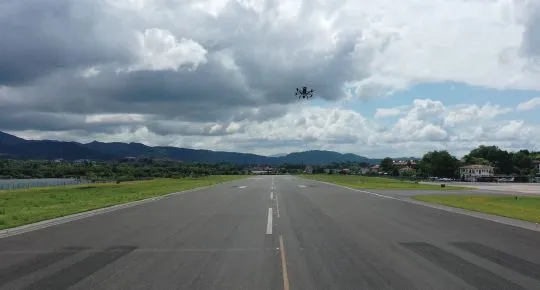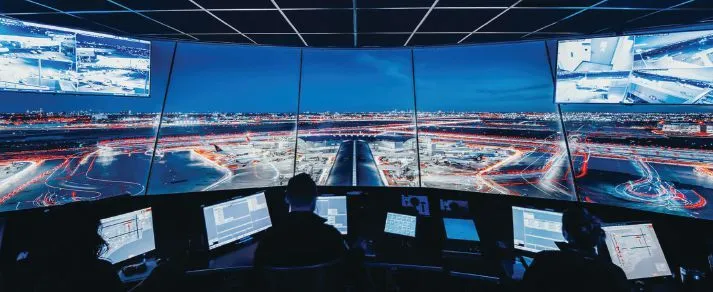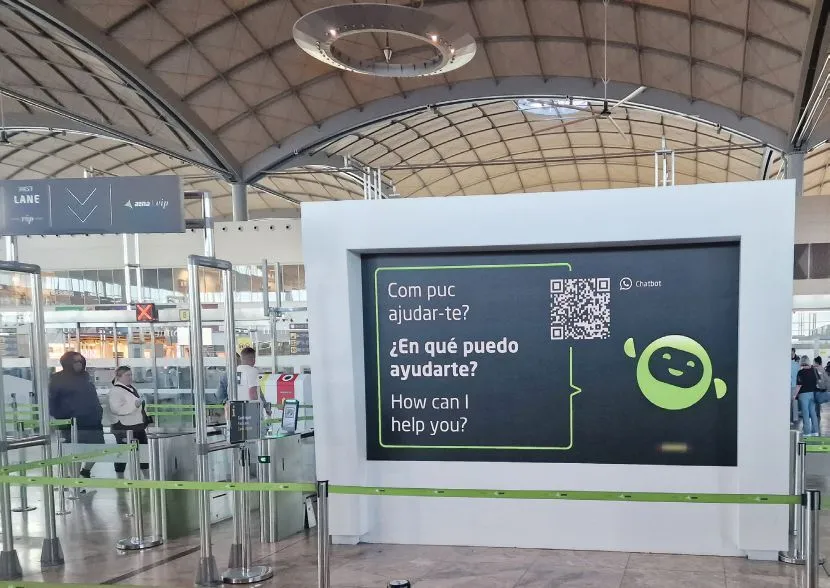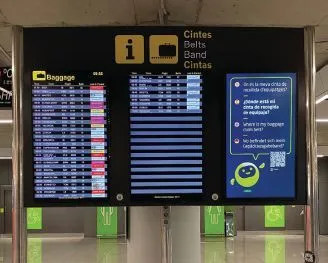PTW takes a look at some specific use cases that illustrate how airports and airlines are using AI to improve their operations and the passenger experience.
Airports continue to be transformed by AI in areas such as demand forecasting, predictive maintenance, autonomous equipment and vehicles, computer vision and biometrics, according to Bob Kwik, worldwide head of airports and ground transportation at Amazon Web Services.
“Brussels Airport started using AI to forecast passenger demand about five years ago,” says Kwik, who discussed the impact of generative AI on airports at last April’s Passenger Terminal Conference in Amsterdam. “More recently, Riyadh Airport built a predictive maintenance forecasting solution for its baggage systems on AWS; and Vanderlande uses Amazon Monitron for predictive maintenance on Heathrow Airport’s baggage handling systems. Autonomous vehicles are also deployed in many airports, such as Aurrigo’s ULD tugs at Changi Airport.
“AWS Partners offers computer vision solutions that measure and improve processes such as passenger flow and aircraft turnaround, for example at Cincinnati Airport. Biometrics is now well established in air travel and continues to grow. DigiYatra’s self-sovereign identity service that uses face biometrics as a single identity token is rolling out at airports across India, and Air Canada recently deployed a facial biometric solution with 99.9% accuracy using Amazon Rekognition.”
Kwik also points to some less well-known examples: “Take Amazon’s Just Walk Out stores, operating in 19 airports. The solution combines computer vision, palm biometrics and sensors with the same transformer-based machine learning models underlying many generative AI applications to create a seamless automated airport retail experience.”
Based on this success, AWS is now exploring other ways generative AI can improve travel, such as in combination with palm biometrics to create an alternative form of identity verification and payment.
“Airports have now started to use generative AI for both customer-facing and internal applications,” says Kwik. “Belfast City Airport recently built a generative AI email draft tool to help duty managers provide faster responses to passenger queries; and airports are beginning to apply generative AI to their buildings’ systems manuals to troubleshoot equipment problems.”
Airports are also adopting generative AI for less aviationspecific uses such as gaining insights and identifying trends from the free-form comments in customer satisfaction surveys and internal employee surveys.
However, despite rapid progress and myriad deployments, Kwik says some misconceptions about the technology persist.
“The first misconception is that AI is new. AI technology has been in use at airports for years. It has evolved from machine learning to deep learning and, most recently, generative AI. One of the biggest concerns about generative AI is that customer data could be exposed to train the model or exposed outside their organization. With generative AI on AWS you can keep your data and applications secure and private; Ryanair built a generative AI employee app on AWS with their own rostering data.”
Another common misperception is that there are just one or two foundation models (FMs) that power generative AI. That simply isn’t the case, according to Kwik: “There is a wide range of FMs. Some are faster than others, some are better at chat, some excel at reasoning. AWS offers a choice of foundation models. A great example is how travel company TUI uses multiple FMs to create high-quality automated content.”
Kwik supports customers across their cloud adoption journey, and recommends senior management undertake training to fully understand the potential of AI. “Airport leaders need to understand the fundamentals of AI and generative AI to determine how the technology can help their businesses,” he says.
“There are many options for training, including free AWS training such as Generative AI for Executives. Next, I’d recommend trying out the technology on real-world business problems. There are lots of ways for airports to get started: deploy a generative AI-powered assistant, such as Amazon Q Business, that can answer questions, provide summaries, generate content and securely complete tasks based on your data and information; work with a technology partner on a specific use case such as an internal or passenger-facing generative AI-enhanced chatbot; or implement a solution with generative AI built in, such as Amazon Connect, which uses generative AI to improve contact center agent productivity.”
With huge potential gains and no time to lose, it’s no surprise that many airports are already well on the road to embracing AI. Read on to discover some specific use cases from airports and airlines around the world.
1) Turnaround
To increase operational efficiency by improving ground handling workflows, Ljubljana Jože Pučnik Airport (LJU) Airport in Slovenia began using an AI-enabled turnaround solution from Assaia back in January 2024. Fraport, the airport operator, is now considering expanding the technology across its airport network, having seen an almost six-minute reduction in average ground delays.

“Assaia’s ApronAI system is installed at all critical gates [including five contact (PBB) gates] at Ljubljana Airport, managed by Fraport Slovenija, covering 96% of passenger O&D traffic,” explains Robert Rauch, innovation project manager at Fraport Slovenija. “It allows the operations team to optimize real-time operations, improving efficiency by assigning appropriate staffing levels based on actual events rather than planned schedules.”
Assaia’s ApronAI system was discovered during Fraport’s Open Pitch Day, where startups and more established companies showcase new technologies to Fraport AG’s Digital Factory. This led to the swift deployment of the system at Ljubljana Airport (one of the first European airports to implement this technology) in early 2024. The hardware and software were installed and integrated in just 139 days, from September 2023 to January 25, 2024.
“Challenges mainly involved trade union and works council representatives, particularly regarding AI and privacy,” notes Rauch. “Timely, transparent communication and adherence to GDPR legislation in Europe were crucial in addressing these concerns.”

By using ApronAI, potential operational challenges can be swiftly identified, leading to improved process efficiency. Decision-makers receive timely updates on predicted delays, enhancing on-time performance. Real-time information helps staff quickly address bottlenecks and reallocate resources.
“A nearly six-minute reduction in average ground delays was observed”
Robert Rauch, Fraport Slovenija
“Over a few months, a nearly six-minute reduction in average ground delays was observed for flights where alerts were acknowledged compared with those without,” reveals Rauch. “This metric demonstrates the effectiveness of ApronAI in improving operational efficiency and reducing delays, offering a clear contrast to manual methods.
“Digital technologies like ApronAI are revolutionizing airport operations by predicting issues and automating processes, making them more efficient. They help manage increased air traffic, reduce delays, enhance safety and optimize resource use. These technologies can address staff shortages, maximize infrastructure use and cut long-term costs, ultimately improving the passenger experience. However, AI must be used responsibly, ethically and with respect for passenger and worker privacy and rights. It is a mindset change, not just technology. Airport digital transformation often fails due to cultural resistance, not technical issues.”

2) Foreign object debris (FOD) detection
A pioneering project at San Sebastian Airport in Spain combines AI, a drone and a 5G network to enable the real-time detection of foreign object debris (FOD) on the runway. The term FOD covers a wide range of materials, including fragments of pavement, construction materials, pieces of luggage and remains of fauna.
The solution uses AI to decipher images captured by a drone and sent over a 5G network, significantly reducing visualization and reaction times. If it detects a foreign object that may pose a safety risk for landing and take-off operations, a warning is triggered and the object is geolocated so that it can be removed.
Developed by the technology company Inetum, the technology uses an AI-based algorithm to analyze images in real time, before transmitting them through the first private 5G network in Spanish airports, installed by Aena and Cellnex Telecom.
“We have combined the potential of 5G, the agility of drones and AI in a cutting-edge project to validate a revolutionary FOD detection technology,” explains Vanesa Calvo Alonso, head of funding and innovation trends, Innovation and Customer Experience Directorate, Aena.
“Most of the effort put into the project, which began in January 2023, has been focused on the development of image acquisition to feed the algorithm in different environmental and meteorological conditions,” she continues. “We focused on the relationship between the height at which the UAS flies and the resolution of the camera required to obtain a high-quality image, free from distortion. Another crucial step was the definition of the requirements for the AI algorithm for FOD detection validation, for which several criteria were defined,” continues Calvo Alonso.
“Another crucial step was the definition of the requirements for the AI algorithm”
Vanesa Calvo Alonso, Aena
“Our main message to other airports would be that through this project, the benefits of the use of drones and AI at airports in terms of efficiency have been confirmed. The success of our project at San Sebastian Airport highlights the importance of collaboration between technology providers and airports. By working together, we can develop and implement innovative solutions that address specific operational needs and improve overall airport performance.”

3) Total airport management (TAM)
Launched at Passenger Terminal Expo 2024 in Frankfurt, Germany, following a successful demonstration with Canada’s Toronto Pearson International Airport in 2023, SITA’s Total Optimizer airport management tool harnesses AI and the principles of total airport management (TAM) to holistically optimize a variety of airport functions.
Unfortunately, many of the tools currently available to staff in a modern airport operations center have a static configuration. This prevents the dynamic adaptation of plans in response to sudden changes or priorities in the airport environment. Total Optimizer allows airport teams to dynamically set the relative priority of different aspects, such as operational performance, capacity provision, revenue generation, cost-efficiency, passenger experience and sustainability.
SITA partnered with Toronto Pearson Airport to deploy a prototype of Total Optimizer that was integrated with airport data sources. Airport staff were able to dynamically optimize stand allocation plans, simply by setting the relative priorities of the airport. The predicted savings, operational efficiencies and additional revenues were then demonstrated to the Toronto Pearson team.
“Toronto Pearson serves approximately 50 million passengers annually, nearing the airport’s designed capacity,” explains Dean Wright, associate director of gating and airport flow at Toronto Pearson. “To maintain seamless operations and enhance passenger and airline partner experiences, we are always exploring solutions to optimize our capacity. After careful consideration, we partnered with SITA for a proof of concept (PoC) using their new Total Optimizer product.
Several factors made this solution a great fit. First, SITA is a strategic partner with whom we have a strong relationship. Additionally, our internal data team had already engineered many of the key data sources required for building the predictive models that would be required for the PoC. This alignment enabled us to implement the platform quickly and efficiently. Ultimately, the combination of trusted partnership, compatibility with existing infrastructure and the speed of deployment were critical to our decision for this PoC.”
For the PoC to succeed, the first step was training the AI engine to understand what defines a ‘good’ stand plan, explains Joey MacSween, program director for airport digitalization at Toronto Pearson, who presented on the PoC alongside Wright at Passenger Terminal Conference 2024.
“How do you weigh improving on-time performance against reducing CO2 emissions?”
Joey MacSween, Toronto Pearson
“While traditional KPIs like on-time performance (OTP), stand utilization and gate holds were key, we also factored in broader impacts such as non-aeronautical revenue, passenger experience and even CO2 emissions,” says MacSween. “This holistic approach ensured that the system could evaluate stand plans from multiple business angles. We worked with SITA to create prediction models for these KPIs using our historical data, allowing the platform to assess every stand allocation against our priorities. This capability was transformational for our resource planners, as manually analyzing such vast and interconnected data across different parts of our business would have been impossible.”
Wright says the project required some specific problems to be solved: “One of the initial challenges was understanding and quantifying the many ways a stand plan impacts different areas of our business. This required a truly cross-functional effort, bringing together various departments to define the KPIs that would guide what constitutes an optimal stand plan.”
Another key challenge was determining how to balance competing KPIs, adds MacSween: “For example, how do you weigh the importance of improving on-time performance (OTP) against reducing CO2 emissions? Our first step was to quantify these outcomes using predictive data models, allowing us to make comparisons in numerical terms – such as whether to prioritize a stand that mitigates a predicted 25-minute delay or one that saves 15kg of CO2 by reducing taxi time.”
During the PoC, Total Optimizer provided flexibility by enabling planners to adjust KPI priorities dynamically throughout the day. For instance, the team could emphasize operational performance during peak morning hours and shift focus to other objectives later in the day.
This capability ensured the stand plan delivered the best outcomes possible across multiple business areas. “The PoC reinforced the value of leveraging data and predictive models to drive meaningful improvements across KPIs that impact the entire business – not just the operational aspects of stand planning,” concludes Wright. “The results demonstrated the platform’s potential to help us achieve our primary goal of increasing airport capacity. Additionally, it predicted positive impacts on other critical areas, including passenger experience, non-aeronautical revenues and overall operational performance.”
MacSween offers some advice to airports interested in adopting something similar: “A critical first step is to collaborate with all business units to identify the KPIs that will define what a ‘good’ recommendation looks like from the AI system. While this might seem straightforward, balancing multiple positive outcomes can be challenging. We invested significant time up front aligning on these KPIs to ensure every department’s priorities were reflected and that we had a shared understanding of how success would be measured. This early collaboration is essential as it sets the foundation for both effective implementation and long-term value generation.”
4) Chatbot
Aena has been using advanced AI to power a chatbot to help passengers across its airport portfolio. Oli began life at Adolfo Suárez Madrid-Barajas Airport and Josep Tarradellas Barcelona-El Prat Airport in December 2022, with a dedicated avatar appearing at different customer touchpoints.
Oli integrates with Aena’s core systems, delivering real-time flight information, maps, security wait times, parking reservations and proactive alerts. For queries beyond its capabilities or when passengers request human assistance, Oli seamlessly connects to contact-center agents.

Key features include a stopover assistant providing personalized connection guidance; a comprehensive travel documentation helper for all passenger types including minors and pets; and the Flappy Oli game for entertainment. Oli speaks eight languages and can be consulted on WhatsApp through a QR code, on aena.es and via a dedicated app, as well as Facebook direct messages, flight information screens or the WeChat application.
“Since December 2022, Oli has revolutionized the passenger experience across Aena’s 41 Spanish airports, serving over two million passengers through text and voice interactions,” explains Celia Leiro del Alamo, customer experience specialist, Aena. “The chatbot emerged from Aena Ventures, our startup accelerator program, where Airport AI [Airbot Technology Limited] won the Passenger Communication challenge. It integrates essential flight information, FAQs and points of interest, among other things, to enhance the travel experience. Further system integrations are in development to expand beyond these capabilities.
“The generative model, implemented last year, enhances intent recognition”
Celia Leiro del Alamo, Aena
“The service initially launched with a discriminative AI model, which excelled at handling most standard passenger queries. However, we observed that passengers often use complex language patterns and include multiple intents in their questions, requiring a more sophisticated approach. This led us to implement a dual AI model system: the original discriminative model for standard queries and a generative model for complex, multi-intent questions. The generative model, implemented last year, enhances intent recognition and generates responses based on Aena’s knowledge base. Notably, conversations using the generative model have achieved an impressive average rating of 4.44.

“With a consistent rating of 4.26/5, Oli is one of Aena’s top-rated services and has been very popular since its launch,” Leiro del Alamo confirms. “Its main advantage lies in its connectivity with other airport and airline chatbots, as well as its multichannel deployment capabilities: web, app, social media and airport information displays. The chatbot can be easily integrated with existing airport information displays without additional maintenance or updates, as it uses the same real-time data source. The result is a comprehensive, seamless information system that’s easily accessible to passengers across all platforms.”
Oli enhances digital communication and handles increased conversation volumes, but Leiro del Alamo insists that it complements rather than replaces vital airport staff: “The chatbot effectively serves passengers who prefer digital interaction, while significantly expanding Aena’s communication capacity. Our expanding digital ecosystem now connects with 39 non-Aena airports worldwide. We’re also collaborating with major Spanish airlines to integrate their systems, further streamlining the passenger journey and creating a more comprehensive service for all travelers.”
This article originally appeared in the January 2025 issue of Passenger Terminal World. To view the magazine in full, click here.


